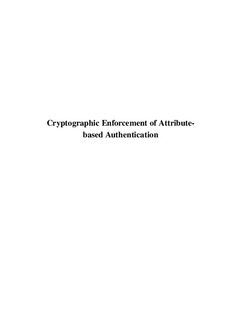| dc.description.abstract | This dissertation investigates on the cryptographic enforcement about attributebased
authentication (ABA) schemes. ABA is an approach to authenticate users
via attributes, which are properties of users to be authenticated, environment conditions
such as time and locations. By using attributes in place of users’ identity information,
ABA can provide anonymous authentication, or more specifically, ABA
enables to keep users anonymous from their authenticators. In addition, the property
of least information leakage provides better protection for users’ privacy compared
with public key based authentication approaches. These properties make it possible
to apply ABA schemes in privacy preserving scenarios, for instance, cloud-based
applications.
The most important security requirements of ABA schemes consist of anonymity,
traceability, unforgeability, unlinkability and collision resistance. In this dissertation,
we combine these security requirements with other properties such as hierarchy
to divide ABA schemes into different categories, based on which we use examples
to demonstrate how to construct these schemes cryptographically. The main
contributions of this dissertation include the following aspects:
We categorize ABA schemes into different types and describe their structures
as well as workflows, such that readers can gain a big picture and a clear
view of different ABA schemes and their relations. This categorization serves
as a guideline how to design and construct ABA schemes.
We provide two examples to demonstrate how to construct ciphertext-policy
attribute-based authentication (CP-ABA) schemes via two different approaches.
Different from key-policy attribute-based authentication (KP-ABA) schemes,
attribute keys generated in CP-ABA schemes are comparatively independent
of relations among attributes. Thus compared with KP-ABA, CP-ABA extends
the flexibility and usage scope of ABA schemes.
We extend the core ABA schemes to hierarchical ABA (HABA) schemes
by adding the property of hierarchy. Then we propose two different types
of hierarchical structures, i.e., user related hierarchical ABA (U-HABA) and
attribute related hierarchical ABA (A-HABA). According to these two hierarchical
structures, an example is provided for each type to show how to use
cryptographic primitives to build HABA schemes.
All ABA schemes discussed above and proposed in this dissertation can be implemented
to assist users to achieve anonymous authentication from their authenticators.
Therefore, these schemes can offer more opportunities to protect users’
privacy, for example, in attribute-based access control (ABAC) and cloud-based
services. | nb_NO |

